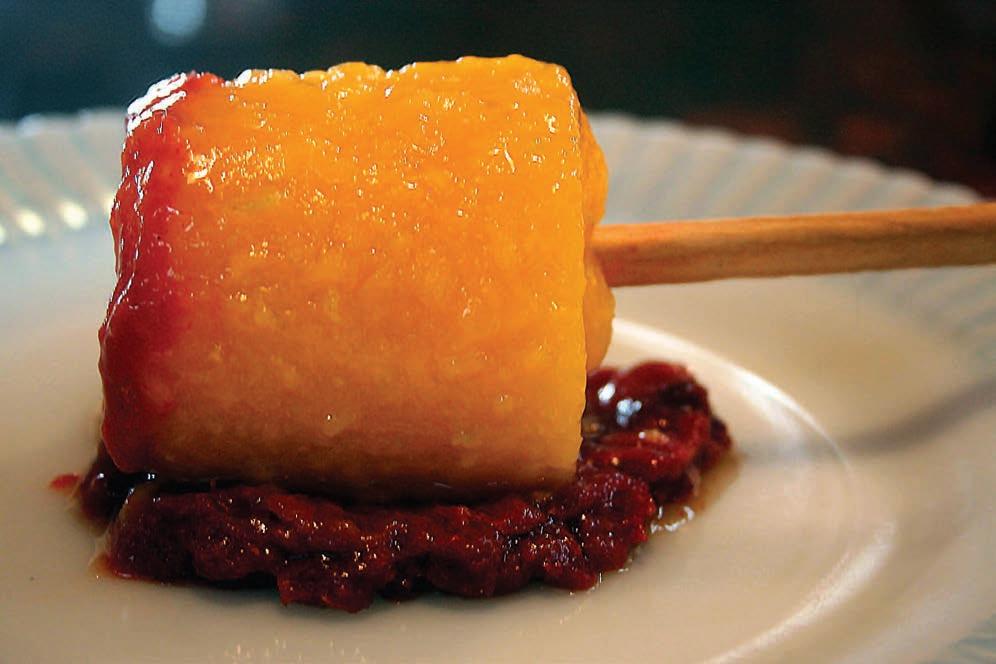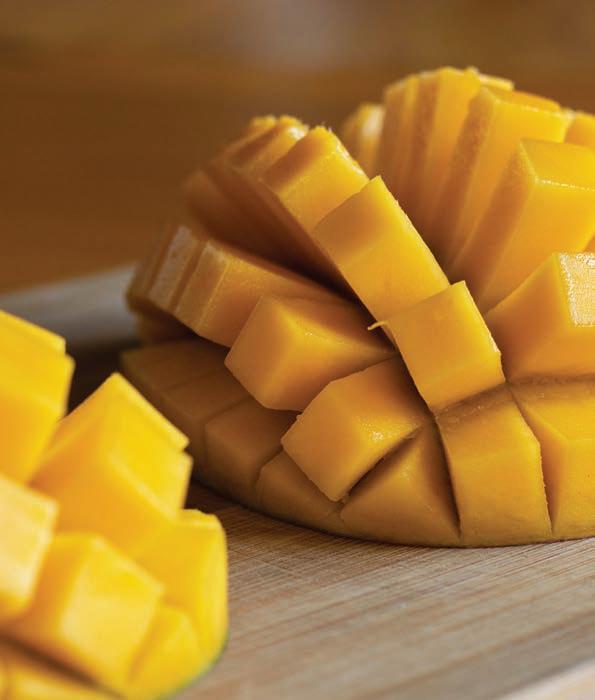
3 minute read
Enjoy Some Bold Mexican Chamoy
MANGONEADA WITH CHAMOY
Photo by Ari LeVaux.
Enjoy Some Bold Mexican Chamoy Enjoy Some Bold Mexican Chamoy
BY ARI LEVAUX
Salsa and guacamole get more glory, but chamoy, lesser known among Mexican condiments, might be more important. This fruit-based sauce is sweet, sour, salty, bitter and muy picante, all at once, a complete flavor that goes with everything. It embodies a certain boldness that’s common in Mexican food. The cuisine is alive and evolving, guided by deep traditions but not bound to them, interconnected by an ethos that finds it perfectly sensible to unroll a tamale onto a hot dog bun.
Chamoy tastes vaguely like BBQ sauce, and I love shoveling it into my mouth atop crispy pork. Most any other meat is equally chamoy-able. And if it’s chamoyable, it’s enjoyable. Smeared onto a slice of melon, chamoy adds a surprising balance. On the rim of a frosty pint glass, it makes your beer more quenching. Mixed with mayo, you might as well put the stuff into an IV bag so I can mainline it.
We can direct our gratitude to a salted plum recipe from the other side of the world. Chamoy is a legacy of a small Japanese Mexican population. Originally made with salted Japanese plums called ume, the sauce is now made with dried apricots and prune plums. This chamoy, which I am going to tell you how to make at home, is relatively wholesome compared to the corn starch, xanthan gum, sodium benzoate and Red No. 40 that comprise most of the stuff from the store. Those bottled chemicals are a faint approximation of the real chamoy, which has only fruit, lime, chile, salt and sugar.
My favorite way to use chamoy, especially in summer, is in a brilliant dish called a mangoneada. It’s basically a mango popsicle, or mango sherbet, that has been treated with chamoy. Only in Mexico might we find a food that is at once too spicy, too sour, too salty, and too sweet, all at the same time, and yet have it all work out so perfectly.
There are many ways to arrange and serve this cold, sassy treat, my favorite being a mango popsicle that you dip into a well of chamoy. So today we have two recipes. The one for chamoy is the most important, because this sauce will make you a true Mexican chef. But the one for mangoneada is also crucial, because it might be your favorite way to use chamoy, and the best thing you try this summer.
DRIED HIBISCUS FLOWER

Photo by AnnaPustynnikova/Getty Images.
FRESH CUT MANGO

CHAMOY SAUCE
It’s the flavor that keeps Mexico masticating. A lot of chamoy recipes use hibiscus, which is relatively subtle compared to the other ingredients. But it does add a nice level of complexity
• ¼ cup dried hibiscus flowers • 1 cup dried apricots • 1 cup dried prunes • ¼ cup sugar • 2 teaspoons salt • 2 tablespoons chile powder (mild, medium or hot, depending on your inclinations) • 5 tablespoons lime juice
Boil four cups of water and add the hibiscus. Strain the flowers and return the tea to the pot. Add the apricots, prunes, salt, sugar and chile powder. Bring to a boil and simmer for 30 minutes. Let cool for ten minutes. Transfer to a blender. Add the lime juice and blend until smooth. Adjust seasonings if you wish. It should be strong yet balanced and complex.
THE MANGONEADA, AKA THE BOSS
This refreshing concoction depends on strong flavors cantilevered against one another, like a sailor leaning off the side of a yacht to keep it from capsizing.
• 3 cups fresh mango chunks • 3 tablespoons lime juice • ¼ cup sugar • ¼ cup chamoy
Blend the mango, lime juice and sugar. Pour the slurry into 8- or 10-ounce plastic cups, about 2/3 full, and put them in the freezer. When partially frozen, place popsicle sticks in the bright orange mango mixture. When they are totally frozen, they are ready to serve.
To serve, remove a popsicle from a cup, and pour the chamoy into the empty cup. Replace the popsicle back into the cup, so it squeezes the chamoy about the sides. Let it sit for a moment so the outer surface of the popsicle can soften and absorb some chamoy. Then lick and re-coat with chamoy as necessary, and repeat.
Ari LeVaux has written about food for The Atlantic Online, Outside Online and Alternet.










